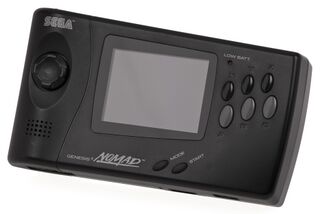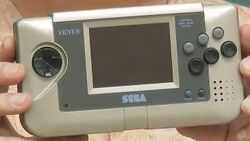Difference between revisions of "Sega Nomad"
From Sega Retro
MarioSnicU (talk | contribs) |
m (→Hardware) |
||
| Line 14: | Line 14: | ||
==Hardware== | ==Hardware== | ||
| − | The Nomad is a handheld video game console, held horizontally, that is designed to play North American Genesis games. It has a feature set identical to a model 2 Mega Drive paired with a [[Six Button Control Pad (Mega Drive)|Six Button Control Pad]], including sharing the same AC power adaptor and video cables | + | The Nomad is a handheld video game console, held horizontally, that is designed to play North American Genesis games. It has a feature set identical to a model 2 Mega Drive paired with a [[Six Button Control Pad (Mega Drive)|Six Button Control Pad]] (with three button compatibility enabled by starting the system while holding {{Mode}}), including sharing the same AC power adaptor and video cables - allowing it to be hooked up to a regular television. Also included is a D-Pad and six face buttons (as well as {{Start}} and {{Mode}} buttons), and even an extra [[DE-9]] port for a second player (though player 1 must always use the controls built into the Nomad unit). As a portable unit, the Nomad offers a high-quality backlit 3" passive-matrix LCD screen, and can be powered by six AA batteries for theoretical play on the go, but this also means it is not compatible with add-ons such as the [[Power Base Converter]], [[Sega Mega-CD]] or [[Sega 32X]]. Also included is a mono speaker and an LED indicating when the batteries are low. |
The Nomad carries two potential problems. First, while Mega Drive games can boast at running at a higher resolution than their [[Game Boy]] rivals, as well as the previous Game Gear, the early LCD technology means that fast action scenes suffer from "ghosting", a blurry graphical effect caused the screen not being able to referesh fast enough. Ghosting was a recurring problem with early 90s handhelds, but the problem is exacerbated on the Nomad; more pixels means intricate details (such as small text) are harder to see, even when no movement is occuring. Similar problems occur when attempting to play [[Sega Master System]] games on the Game Gear via the [[Master Gear Converter]]. Second, like the Game Gear before it, the otherwise vital fluorescent screen backlight is a drain on power. The Nomad typically pulls around three to five hours of play with the backlight on; excellent for what it does, but this can never compare to the famous 10+ hours of main competitor, the Game Boy. However, a battery accessory called the [[Nomad PowerBack]], which is charged via an AC adapter, can extend play time by a couple of hours. | The Nomad carries two potential problems. First, while Mega Drive games can boast at running at a higher resolution than their [[Game Boy]] rivals, as well as the previous Game Gear, the early LCD technology means that fast action scenes suffer from "ghosting", a blurry graphical effect caused the screen not being able to referesh fast enough. Ghosting was a recurring problem with early 90s handhelds, but the problem is exacerbated on the Nomad; more pixels means intricate details (such as small text) are harder to see, even when no movement is occuring. Similar problems occur when attempting to play [[Sega Master System]] games on the Game Gear via the [[Master Gear Converter]]. Second, like the Game Gear before it, the otherwise vital fluorescent screen backlight is a drain on power. The Nomad typically pulls around three to five hours of play with the backlight on; excellent for what it does, but this can never compare to the famous 10+ hours of main competitor, the Game Boy. However, a battery accessory called the [[Nomad PowerBack]], which is charged via an AC adapter, can extend play time by a couple of hours. | ||
Latest revision as of 16:54, 22 December 2024

| |||||||||||||||

| |||||||||||||||
| Sega Nomad | |||||||||||||||
|---|---|---|---|---|---|---|---|---|---|---|---|---|---|---|---|
| Manufacturer: Sega of America | |||||||||||||||
|
The Sega Nomad, codenamed Venus, is a handheld video game console manufactured by Sega. It is a portable Sega Mega Drive (Genesis), and Sega's second handheld system after the Sega Game Gear. The Nomad shares a similar concept with the semi-portable Sega Mega Jet, and only saw release in North America.
Contents
Hardware
The Nomad is a handheld video game console, held horizontally, that is designed to play North American Genesis games. It has a feature set identical to a model 2 Mega Drive paired with a Six Button Control Pad (with three button compatibility enabled by starting the system while holding MODE ), including sharing the same AC power adaptor and video cables - allowing it to be hooked up to a regular television. Also included is a D-Pad and six face buttons (as well as START and MODE buttons), and even an extra DE-9 port for a second player (though player 1 must always use the controls built into the Nomad unit). As a portable unit, the Nomad offers a high-quality backlit 3" passive-matrix LCD screen, and can be powered by six AA batteries for theoretical play on the go, but this also means it is not compatible with add-ons such as the Power Base Converter, Sega Mega-CD or Sega 32X. Also included is a mono speaker and an LED indicating when the batteries are low.
The Nomad carries two potential problems. First, while Mega Drive games can boast at running at a higher resolution than their Game Boy rivals, as well as the previous Game Gear, the early LCD technology means that fast action scenes suffer from "ghosting", a blurry graphical effect caused the screen not being able to referesh fast enough. Ghosting was a recurring problem with early 90s handhelds, but the problem is exacerbated on the Nomad; more pixels means intricate details (such as small text) are harder to see, even when no movement is occuring. Similar problems occur when attempting to play Sega Master System games on the Game Gear via the Master Gear Converter. Second, like the Game Gear before it, the otherwise vital fluorescent screen backlight is a drain on power. The Nomad typically pulls around three to five hours of play with the backlight on; excellent for what it does, but this can never compare to the famous 10+ hours of main competitor, the Game Boy. However, a battery accessory called the Nomad PowerBack, which is charged via an AC adapter, can extend play time by a couple of hours.
Though never released in PAL regions, the Nomad can be modified to play PAL games in a similar manner as the Genesis/Mega Drive consoles.
History
The Sega Nomad was designed by Sega of America, likely as another attempt to extend the shelf life of the already successful Sega Genesis (Sega Mega Drive in all other regions). At the time of release, home consumers were geared up for a new generation of video game consoles, namely the Sega Saturn and Sony PlayStation, but with an established game library of over 600 titles at this point and vastly improved hardware over the competition (mainly Nintendo's Game Boy), it was presumed that there was still a place for the Nomad, particularly when Game Gear sales were on the decline.
It is rumoured that at one point, Venus was to be a true successor to the Game Gear sporting a touch-screen interface, some years before the concept was pioneered with the ill-fated Game.com by Tiger Electronics. At the time, it was thought that a system utilising this technology would cost roughly $289 to manufacture, and so the idea was scrapped in favor of a handheld Genesis instead. Even in this form, the Venus project was held back for several months due to its perceived high cost[2].
The Nomad debuted on select test markets across North America in October 1995[3] for an asking price of US$179. It was a slow rollout at first, distributed in limited quantities across 500 Toys 'R' Us stores[4] until a wider release in early 1996[5]. Though the handheld received praise from critics, sales were sluggish, even after a US$100 price drop in the months which followed. It was discontinued shortly after. Despite this, it is estimated that roughly one million Nomad units were sold.
The Nomad saw a limited distribution in Asia, but never made it to Europe (though there were plans at one stage to bring it there).
In many countries, Nomad entered the market thanks to the gray market.
Prototype Hardware
On the 30th of November 2020, Sega showed a prototype of the Nomad hardware, still labelled with the Venus planet codename, on a YouTube video.[6]
Technical Specifications
- See Sega Mega Drive specifications for further specifications
The hardware is largely similar to the Majesco Genesis 3 released in 1998, including the lack of Sega Master System backwards-compatibility (fixable with a mod on both systems), and the consolidated ASICs compared to the original model.
| Power | 9V 3.5W |
| Dimensions (metric) | 18.5cm × 10cm (10.7cm on the left handside) × 3.4 (5cm on the left handside) |
| Dimensions (imperial) | 7¼" × 4" (4¼" on the left handside) × 1¾" (2" on the left handside) |
Game Issues
The following Genesis titles are known to have difficulty with or not to work at all on the Nomad:
- Decap Attack (Button compatibility issues, is not fixed even using 3-button mode compatibility)
- Forgotten Worlds (Fully incompatible with 6 button pad, not only on Nomad)
- Golden Axe II (Require using the MODE button to activate 3-button mode. Game is fully playable using it)
- King of the Monsters (Button compatibility issues, is not fixed even using 3-button mode compatibility)
- Phantasy Star MD (Master System game in a Mega Drive cart, Nomad has Master System mode disabled)
- Outback Joey (requires the fitness sensor peripheral HeartBeat Catalyst)
- Trouble Shooter (Button compatibility issues, is not fixed even using 3-button mode compatibility)
- X-Men (The game requires the player to reset the console at a certain point to continue, the Nomad lacks a reset button)
Magazine articles
- Main article: Sega Nomad/Magazine articles.
Promotional material
Patents
Physical scans
References
- ↑ Sega FY 1997 Brand Review, page 5
- ↑ GamePro, "March 1995" (US; 1995-xx-xx), page 158
- ↑ Ultimate Gamer, "November 1995" (US; 1995-1x-xx), page 14
- ↑ EGM², "January 1996" (US; 199x-xx-xx), page 32
- ↑ Press release: 1995-08-22: Sega Genesis Nomad Embarks On It's Debut Voyage
- ↑ https://www.youtube.com/watch?v=wqdN_L4YaDE#t=11m32













